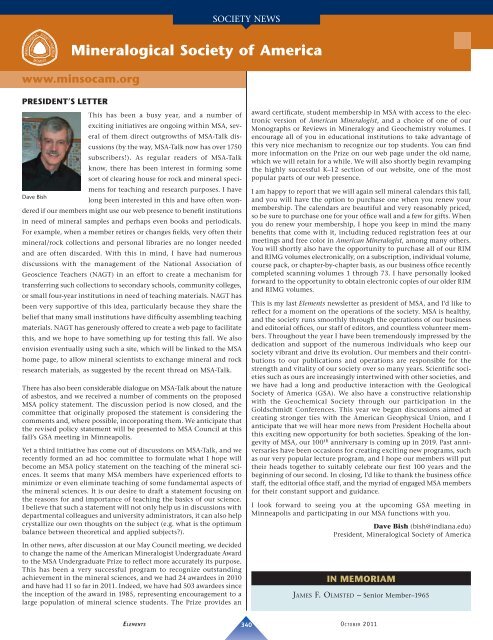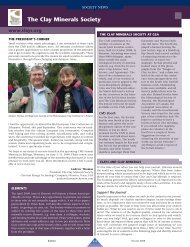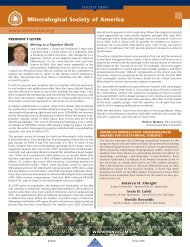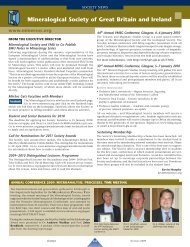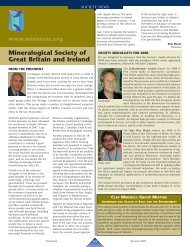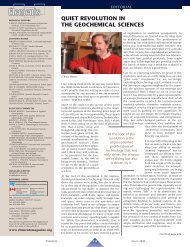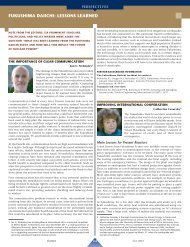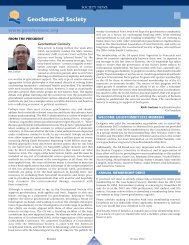MinSocAm - Elements Magazine
MinSocAm - Elements Magazine
MinSocAm - Elements Magazine
You also want an ePaper? Increase the reach of your titles
YUMPU automatically turns print PDFs into web optimized ePapers that Google loves.
Mineralogical Society of Americawww.minsocam.orgPRESIDENT’S LETTERThis has been a busy year, and a number ofexciting initiatives are ongoing within MSA, severalof them direct outgrowths of MSA-Talk discussions(by the way, MSA-Talk now has over 1750subscribers!). As regular readers of MSA-Talkknow, there has been interest in forming somesort of clearing house for rock and mineral specimensfor teaching and research purposes. I haveDave Bishlong been interested in this and have often wonderedif our members might use our web presence to benefit institutionsin need of mineral samples and perhaps even books and periodicals.For example, when a member retires or changes fields, very often theirmineral/rock collections and personal libraries are no longer neededand are often discarded. With this in mind, I have had numerousdiscussions with the management of the National Association ofGeoscience Teachers (NAGT) in an effort to create a mechanism fortransferring such collections to secondary schools, community colleges,or small four-year institutions in need of teaching materials. NAGT hasbeen very supportive of this idea, particularly because they share thebelief that many small institutions have difficulty assembling teachingmaterials. NAGT has generously offered to create a web page to facilitatethis, and we hope to have something up for testing this fall. We alsoenvision eventually using such a site, which will be linked to the MSAhome page, to allow mineral scientists to exchange mineral and rockresearch materials, as suggested by the recent thread on MSA-Talk.There has also been considerable dialogue on MSA-Talk about the natureof asbestos, and we received a number of comments on the proposedMSA policy statement. The discussion period is now closed, and thecommittee that originally proposed the statement is considering thecomments and, where possible, incorporating them. We anticipate thatthe revised policy statement will be presented to MSA Council at thisfall’s GSA meeting in Minneapolis.Yet a third initiative has come out of discussions on MSA-Talk, and werecently formed an ad hoc committee to formulate what I hope willbecome an MSA policy statement on the teaching of the mineral sciences.It seems that many MSA members have experienced efforts tominimize or even eliminate teaching of some fundamental aspects ofthe mineral sciences. It is our desire to draft a statement focusing onthe reasons for and importance of teaching the basics of our science.I believe that such a statement will not only help us in discussions withdepartmental colleagues and university administrators, it can also helpcrystallize our own thoughts on the subject (e.g. what is the optimumbalance between theoretical and applied subjects?).In other news, after discussion at our May Council meeting, we decidedto change the name of the American Mineralogist Undergraduate Awardto the MSA Undergraduate Prize to reflect more accurately its purpose.This has been a very successful program to recognize outstandingachievement in the mineral sciences, and we had 24 awardees in 2010and have had 11 so far in 2011. Indeed, we have had 503 awardees sincethe inception of the award in 1985, representing encouragement to alarge population of mineral science students. The Prize provides anaward certificate, student membership in MSA with access to the electronicversion of American Mineralogist, and a choice of one of ourMonographs or Reviews in Mineralogy and Geochemistry volumes. Iencourage all of you in educational institutions to take advantage ofthis very nice mechanism to recognize our top students. You can findmore information on the Prize on our web page under the old name,which we will retain for a while. We will also shortly begin revampingthe highly successful K–12 section of our website, one of the mostpopular parts of our web presence.I am happy to report that we will again sell mineral calendars this fall,and you will have the option to purchase one when you renew yourmembership. The calendars are beautiful and very reasonably priced,so be sure to purchase one for your office wall and a few for gifts. Whenyou do renew your membership, I hope you keep in mind the manybenefits that come with it, including reduced registration fees at ourmeetings and free color in American Mineralogist, among many others.You will shortly also have the opportunity to purchase all of our RIMand RIMG volumes electronically, on a subscription, individual volume,course pack, or chapter-by-chapter basis, as our business office recentlycompleted scanning volumes 1 through 73. I have personally lookedforward to the opportunity to obtain electronic copies of our older RIMand RIMG volumes.This is my last <strong>Elements</strong> newsletter as president of MSA, and I’d like toreflect for a moment on the operations of the society. MSA is healthy,and the society runs smoothly through the operations of our businessand editorial offices, our staff of editors, and countless volunteer members.Throughout the year I have been tremendously impressed by thededication and support of the numerous individuals who keep oursociety vibrant and drive its evolution. Our members and their contributionsto our publications and operations are responsible for thestrength and vitality of our society over so many years. Scientific societiessuch as ours are increasingly intertwined with other societies, andwe have had a long and productive interaction with the GeologicalSociety of America (GSA). We also have a constructive relationshipwith the Geochemical Society through our participation in theGoldschmidt Conferences. This year we began discussions aimed atcreating stronger ties with the American Geophysical Union, and Ianticipate that we will hear more news from President Hochella aboutthis exciting new opportunity for both societies. Speaking of the longevityof MSA, our 100 th anniversary is coming up in 2019. Past anniversarieshave been occasions for creating exciting new programs, suchas our very popular lecture program, and I hope our members will puttheir heads together to suitably celebrate our first 100 years and thebeginning of our second. In closing, I’d like to thank the business officestaff, the editorial office staff, and the myriad of engaged MSA membersfor their constant support and guidance.I look forward to seeing you at the upcoming GSA meeting inMinneapolis and participating in our MSA functions with you.Dave Bish (bish@indiana.edu)President, Mineralogical Society of AmericaIN MEMORIAMJAMES F. OLMSTED – Senior Member–1965ELEMENTS 340OCTOBER 2011
NOTES FROM CHANTILLY• Results of the 2011 election: The 2012 president of the society isMichael F. Hochella Jr.; the vice president is John M. Hughes. AndreaKoziol was elected secretary, and Darrell J. Henry remains in officeas treasurer. The new councilors are Christine M. Clark and KimberlyT. Tait. They will join continuing councilors Wendy A. Bohrson,Sumit Chakraborty, Pamela C. Burnley, and Guy L. Hovis.• The following short courses are planned for 2012:Applied Mineralogy of Cement and Concrete (MaartenBroekmans, organizer), to be held in conjunction with the FirstInternational Congress on Durability of Concrete (17–21 June 2012;www.icdc2012.com) in Trondheim, NorwayEnvironmental Arsenic Mineralogy, Geochemistry &Microbiology (Rob Bowell, organizer), which will coincide withthe International Geological Congress (5–10 August 2012) inBrisbane, AustraliaSpectroscopic Methods in Mineralogy and Material Sciences(Grant Henderson, Daniel Neuville, and Robert Downs, organizers),which will be held immediately before the Goldschmidt Conferencein Montreal, Canada, in June 2012• MSA members were contacted electronically in September to renewtheir membership for 2012. Members who renew and pay onlinebefore 31 October 2011 will receive a $5 dues discount; the discountreflects cost savings to MSA from members who renew early online.There will be several electronic reminders before a paper copy issent during November to those who do not renew online by theend of October.• Members and fellows who are in the senior, honorary, and life categoriesare sent renewal notices. They need not pay dues, but aresent notices as the best way to prompt an update of membershipinformation, particularly mail and e-mail addresses.Members qualify for senior member or senior fellow status if theyhave reached the age of 65, have retired from full-time professionalemployment, and have been a member of the society for at least 30years. Senior members and fellows retain all benefits of MSA membership(receiving <strong>Elements</strong>, voting, reduced rates on MSA products,etc.), but need not pay dues. They can subscribe to the paper orelectronic versions of American Mineralogist or other journals, purchasesociety publications, and attend short courses all at memberrates. If you are interested in senior status, select senior member orfellow dues on your next renewal and write us in the text box thatyou would like to become a senior member.• If you subscribe to other journals through MSA—Journal of Petrology,Physics and Chemistry of Minerals, Rocks & Minerals, Mineral News, orGems & Gemology—please renew early. MSA needs to forward yourrenewal to the respective publishers before your subscriptionruns out.J. Alex Speer, MSA Executive Directorjaspeer@minsocam.org2012 CALENDAR: ARIZONA MINERALSArizona was granted statehood onFebruary 14, 1912. This calendar ispart of a community-wide Centennialtribute to Arizona’s minerals and minesand to their champions.Published by Lithographie, LLC, incooperation with MSA and MartinZinn Expositions, it is available fromMSA, www.minsocam.org.REVIEWS IN MINERALOGY & GEOCHEMISTRYMINERALOGICAL SOCIETY OF AMERICAAND THE GEOCHEMICAL SOCIETYVolume 73 • Sulfur in Magmas and Melts:Its Importance for Natural and TechnicalProcesses, Harald Behrens and James D.Webster, Editors. i–xiv + 578 pages, 2011 ISBN978-0-939950-87-4, $40 ($30 for members ofMSA, GS, CMS)Following an overview in chapter 1, thisvolume is divided into 4 parts: (1) Analyticaland Spectroscopic Methods – chapters 2 and 3;(2) Physical and Chemical Properties ofS-Bearing Silicate Melts – chapters 4–7; (3)Constraints from Natural and ExperimentalSystems – chapters 8–11; and (4) Natural andTechnical Applications – chapters 12–16.For more description, a table of contents of this book, and online ordering, visitwww.minsocam.org or contact Mineralogical Society of America, 3635 ConcordePkwy Ste 500, Chantilly, VA 20151-1110, USA; phone: +1 (703) 9950; fax: +1 (703)652-9951; e-mail: business@minsocam.org.AMERICAN MINERALOGISTEDITORS: Martin Kunz, Jennifer Thomson, and Ian SwainsonCall for Special Associate EditorsOf course, all American Mineralogist associate editors are special.They are hardworking and very generous of their time. A specialassociate editor would organize papers on a specific topic to createa collection—see the Amorphous Materials collection, for example,via GeoScienceWorld or the MSA website (http://ammin.geoscienceworld.org/misc/specialissuelist.dtl).We would like volunteers for the topics of:REE MineralogyMineralogy and the Nuclear IndustryDeep Earth and Planetary Mineralogy—High-P and High-T MineralsAdditional topic suggestions welcome!All special collection papers go through the same peer review andeditorial process as any other paper. They are published when readyand not held up waiting for slower papers to finish. But the collectionalso grows virtually over time via the web!Would you like to be a special associate editor for one of these topics?In this capacity, you would:• Organize a call for papers on your topic• Find reviewers for submissions• Create detailed revision instructions for authors• Recommend acceptance (or rejection) to the editors• Provide additional editing help as needed• Write a preface or introduction to go with the first batch of papersInquiries are welcome about volunteering as an associate editor.Contact and other information: ww.minsocam.org/MSA/AmMin/Special_Section.html.Quick FactsAverage of recent 316 papers: submission-to-acceptance time:137 days (~4.6 months) (s.d. 88 days) • Submission-to-publication:293 days (~10 months) (s.d. 99 days) • See our list of most read andmost cited papers via GSW: http://ammin.geoscience- world.org.American MineralogistFounded in 1916ELEMENTS 341OCTOBER 2011


